
january 2005
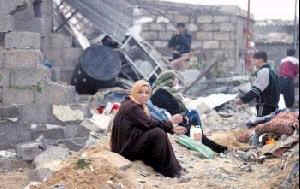
Photo (Alrai, 1/3/05).
not
a tsunamai of nature but of man
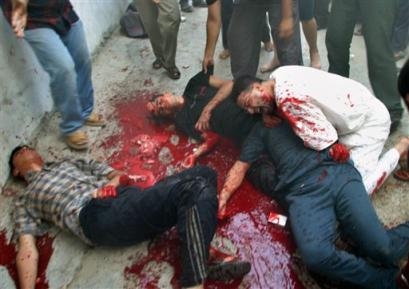
From: "Rafah today"
<rafahtoday@yahoo.com>
To: <Gazanews@yahoo.com>
Subject: New year 2004: The new year 2005: Death Stalks
the People of Khanyounis
Date: 31 December 2004 19:18
Dear friend:
Human shreds, human legs, arms, hand, bones and fingers
are spreaded everywhere at Khanyounis refugee Camp.
Words are not enough to express about what has been going
on here.. Have a look at what is happening right now at
Khanyounis refugee Camp. Have a look at the result of the
international silence towards what has been going on
here. the IOF have named the incursion by " Violet
Iron incursion".
The children of Khanyounis refugee Camp appeal to you and
all free people to stop what is happening at these
moments, in the name of the "democratic
countries".
For more information please visit www.rafahtoday.org and
let your friends , media and everyone around about what
is going on here. please have a look at the attached
photo that represent "some" of what is going on
here.
Sad greetings!
Mohammed
-------------------------------------
Death
Stalks the People of Khan Younis
by Mohammed
Omer
reporting from Khan Younis, southern Gaza Strip,
Occupied Palestine
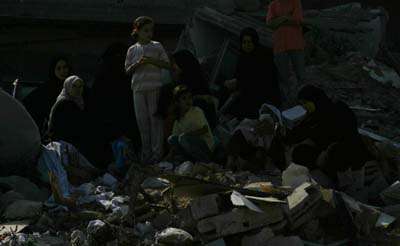
"
When the sunshine disappears": Questions start
chasing the mind of homeless families, and the most
important question that they think about at the moment
is:" Where shall we stay this night after
demolishing our house?"
It is pitch dark in the al Nimsawi neighborhood of Khan
Younis refugee camp in the southern Gaza Strip, an area
of this city of a quarter-million close to the Israeli
settlement of Neve Dakalim. Suddenly the black sky is red
with flames, automatic fire from the circling Apache
gunships, then eerie white fire from the tank shells and
mortar fire from state-of-the-art tanks invading the
crowded streets. The white and red flares give momentary
glimpses of wave after wave of men, women, toddlers,
children, and elderly people fleeing the destruction.
The methods are familiar to everyone in Gaza after four
years of intifada—the loudspeaker announcements from
the Israeli army ordering people to leave their houses,
the machinegun fire from circling Apaches, even the
deaths and injuries are, sadly, very familiar by now.
Only the names of the incursions—the Israeli army
always assigns names to prolonged attacks—and the
reasons given for them, change. This one is called
Operation Orange Iron, and, according to the official
announcements, this is a "response" to a Qassam
rocket fired by the militants at Neve Dakalim settlement
that injured an Israeli soldier.
This is the deadliest incursion since the death of Yassir
Arafat on 11 November. So far, there have been 11
civilian fatalities and 71 injuries—and this attack,
now in its third night, started only hours
after Israeli Prime Minister Ariel Sharon told the
international media of the prospects for peace.
Watching the destruction from a somewhat safe distance
sears nightmare images into the memory—an older man,
not really able to hurry but running nonetheless,
carrying his sandals in his hand as he tries out-run the
tanks over broken pavement; a little girl, perhaps 10
years old, winter jacket thrown over her nightclothes,
clutching her schoolbag. She probably knows that very
shortly, her home will be a pile of rubble, and her
schoolbooks are what she decided to save. Close to her is
a harried woman holding a baby, calling to her four
children to hurry along. It's hard to know which is more
haunting—the elderly people telling their grown sons
and daughters to see to the grandkids and let them manage
alone, or the toddler clinging to his mother with one
hand, his toy truck in the other.
Watching a house demolition is harrowing too. The
background rumble of the massive American-made bulldozer
is almost drowned out by the groans of the concrete and
rebar houses. There is so much noise as the walls, floors
and roofs slowly buckle and finally fall that it seems
the houses themselves are protesting their destruction.
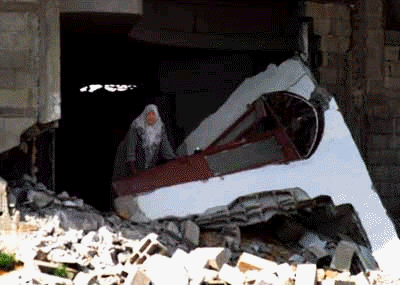
In the cold, rainy winter night, this small ocean of
humanity surging toward the center of Khan Younis can
find few safe harbors. Some of the families took
temporary refuge in a classroom of the UNRWA school.
"This must be what it was like in when the Israelis
forced us out of our homes in El Nakba," said one
father about 30 years old.
"El Nakba"—"the
catastrophe"—was the 1948 attack on Palestinian
towns and villages that turned millions of Palestinians
into refugees. The man who said this is obviously not old
enough to have lived through El Nakba himself, but no
doubt heard about it from his parents. Indeed, any school
child in Gaza or the West Bank can explain El Nakba in
detail. And now, even children like Ahlam, a girl of 11,
are asking surprisingly adult questions: "Why,"
you hear from Ahlam and many other kids, "why are
the soldiers in our land? Why are they doing this to us?
Why do they kill us? What did we do?"
In last night's attack, the third night of Operation
Orange Iron, some 300 civilians had to flee their homes.
Tens of houses were destroyed, leaving hundreds homeless,
but the exact numbers will be hard to get for a few days.
Only a local resident can walk around and know exactly
which pile of rubble was a one-storey or multi-storey
dwelling. Early reports say 30, even 40 or more houses
flattened, but no one can be sure till the Israeli Army
stops the shelling and aerial bombardment. The official
Israeli Occupation Forces announcement says Operation
Orange Iron will continue for several days more, "as
long as necessary" to stop the militants' launching
Qassam rockets from the Al Nimsawi neighborhood.

Many of the adults in Khan Younis, however, suspect the
ferocity of the attack on their city has been sparked by
last Sunday's militant coup against an Israeli watchtower
at the Rafah Terminal crossing. After digging an 800
meter tunnel over several months, the militants emplaced
some 3000 lbs of explosives under an Israeli military
post that is part of the Egypt/Gaza border crossing. The
Israeli media confirmed that the explosion killed 6
Israeli soldiers and wounded 8 more. Two Palestinian
gunman were then killed in the firefight that was phase
two of the militant attack.
In a press release soon afterward, the Fatah Hawks, the
militant wing of the Fateh Party, and Hamas, claimed
joint responsibility for the successful operation.
Ahlam's father told me, "The Israeli army always
seeks a big revenge when the militants kill their
soldiers. We heard they are killing people in Rafah too,
but they can send their tanks and Apaches against us
easily enough."
The militant groups in Khan Younis have been retaliating,
though vastly outnumbered and outgunned. So far, one
Israeli soldier has been wounded by anti-tank fire.
Hospitals and Ambulances Targeted
Khan Younis's Nasser Hospital is crowded with casualties,
along with families finding a bit of floorspace in the
hallways and lobby. In the orthopedic surgery department,
ambulance driver Hassan Abu Samrah, 45, lies face-down on
a gurney while a doctor treats a gunshot wound in his
leg. Abu Samrah was trying to rescue two civilians
injured by Israeli tank fire near the hospital, and ended
up needing rescue himself. "Before I got within
sight of the tanks," he explained, "I turned on
the flashing red lights on the ambulance roof and had the
siren going as loud as possible." The ambulance is
also marked "AMBULANCE" in huge letters on
every flat surface. "They had to see and hear
me," he said, "but they fired on the ambulance.
Still, I thought I might get the injured people loaded
inside and get away, but suddenly my face was on the
ground and I saw my leg was bleeding—they'd shot
me." Another ambulance crew finally got all three
back to Nasser Hospital.
The hospital itself—contrary to all
internationally-accepted rules of engagement—has
also become a target. The Israeli army bulldozers
destroyed the western part of the hospital in the first
few hours of the incursion and has periodically been
shooting at the hospital. The hospital director, Dr.
Mohia Al Deen Al Faraa, explained, "The shelling
directed at us is ongoing. Some of our patients are in
danger of being hurt all over again in their hospital
beds. So far, we have had 11 fatalities arrive, plus
another 71 injured. Most of the injured are civilians
with wounds in the head and chest." The Israeli army
snipers have a well-deserved reputation for accuracy, so
all these upper-body injuries suggest they have orders to
shoot to kill.
Journalists Targeted
Journalists and photographers covering these incursions
take all possible pains to identify themselves very
obviously. A group of five photographers and journalists
were nonetheless targeted by an Israeli tank. Despite
their helmets and vests marked "TV" and
"PRESS" with big phosphorescent letters, the
tank fired a shell directly at them, injuring Mahmoud Al
Hums of the AFB, Mohammed Saber of ABI, and Hatem Mussa
of the Associated Press. Said one of their group who
escaped unharmed, "There's no possible way this was
an accident, no way the tank gunner didn't know we were
press. Our vests and helmets are all marked in
glow-in-the-dark letters. But they fired straight at us,
we scattered, but my three colleagues were caught by the
shrapnel." Two have serious facial and head injuries
and are in guarded condition, the third is
stable, said medical sources.
City-wide Shortages
Although the Al Nimsawi neighborhood has come in for the
worst of Operation Orange Iron, all of Khan Younis's
quarter-million citizens are suffering from electricity
and water shortages. Almost all the city has been with
without electricity and running water since the first
hours of the three-day-old attack. As families run out of
bottled water, they cannot be resupplied by the Red
Crescent/Red Cross and other relief groups due to the
Israeli army cordon sealing off the city. And there seems
to be no end in sight: "The Forces are prepared to
stay in the refugee camp for as long as it takes to
secure quiet in the Israeli communities," Lieutenant
Colonel Ofer Vinter said on the Israeli Army radio
station.
There is an unsettling sense of deja vu throughout Gaza
at these latest incursions. Just as happened during
"Operation Rainbow" in Rafah, the attack that
killed 40 last May and prompted an international outcry,
besieged Khan Younis is even running out of space for the
dead. In May, the morgue refrigerators in Rafah's Al
Najjar Hospital were full, the bereaved families were
under fire and could not leave their homes to bury their
dead, and the bodies had to be stored in commercial
vegetable refrigerators. Now, a few months later, the
same gruesome scenario is unfolding again, as the
mortuary refrigerators in Nasser Hospital are full to
capacity, and the Israeli attack is targeting the
cemetery. So the bereaved families cannot bury their
loved ones. In Gaza, even the dead can be homeless.
Israeli Prime Minister Sharon was talking about peace in
the future mere hours before Operation Orange Iron
started its carnage in Khan Younis. British Prime
Minister Tony Blair is scheduled to arrive in the West
Bank city of Ramallah this Wednesday to discuss
re-starting the peace process with PLO Chairman Mahmoud
Abbas and Prime Minister Ahmed Qurie—while, very
possibly, the Apaches are still shelling Khan Younis.
Predictably, the Palestinian Authority has condemned this
latest attack on a civilian population. "This
escalation of aggression will destroy any chance to
proceed with the peace process," said PA spokesman
Nabil Abu Rudinah.
Diplomats in comfortable conference rooms issuing
measured statements while Palestinian civilians die in
the streets is an all-too-familiar situation for the
people of Gaza. As one elderly man put it,
"Sometimes our fighters kill a soldier or an Israeli
settler—then they kill 10, 20, even a hundred of us.
Is this justice? Can they imagine for a moment this makes
us less angry?" Another mother, huddling in the
hospital hallway with her children, said, "We hardly
dream of peace any more—just for a night when we can
sleep till morning without hearing shelling and Apaches
over our heads, without being afraid we'll be runing from
the tanks."
-------------------------------------------------------------
rafahtoday@yahoo.com
"The world is a dangerous place to live; not because
of the people who are evil, but because of the people who
don't do anything about what is happening."
www.rafahtoday.org
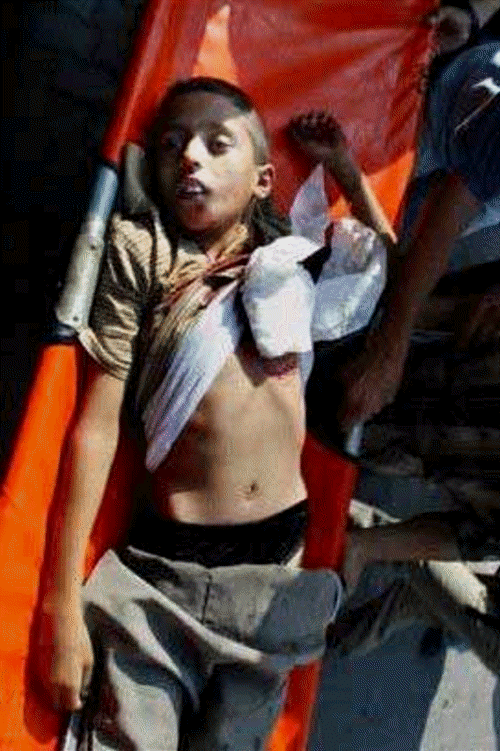
Photos Khan of RafahToday